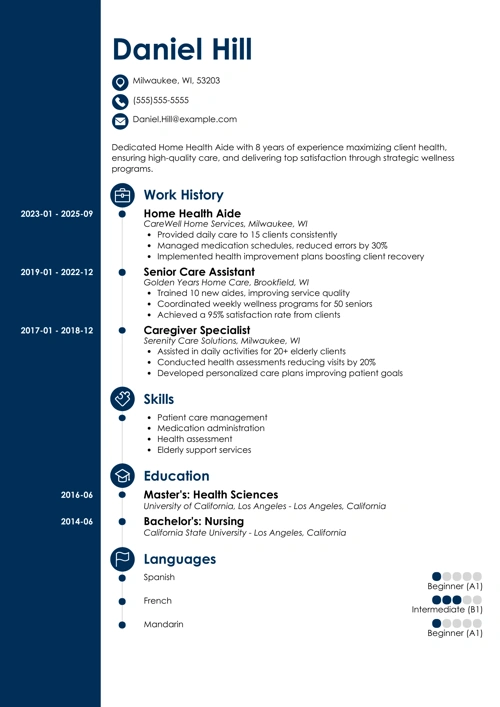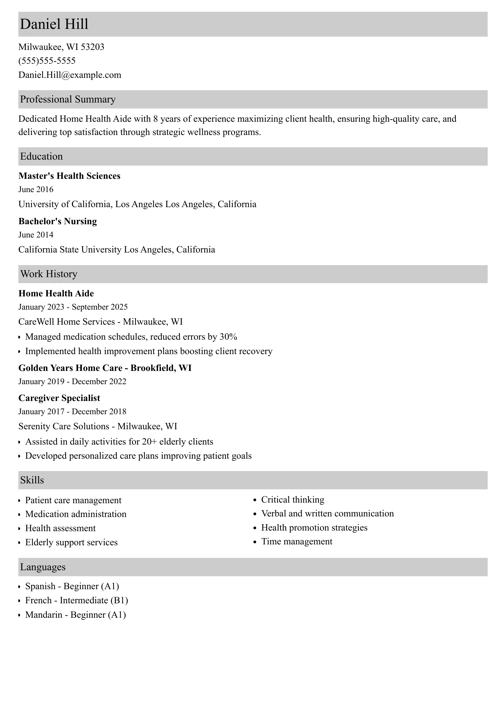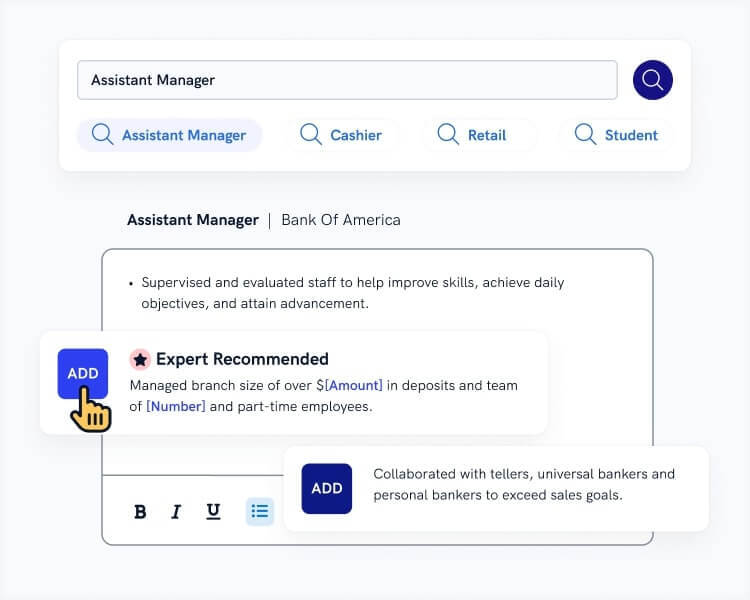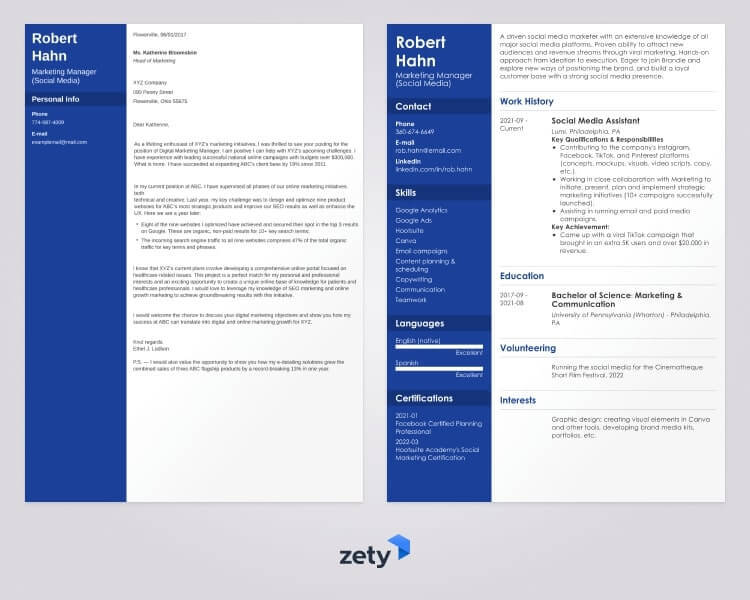You undoubtedly know how crucial first impressions are—they shape how people remember you. That’s why mastering a professional self-introduction is essential.
In this guide, I'll explain why you have to know how to introduce yourself well in different contexts, and how to do it right. You'll also see some self-introduction examples you can use for inspiration. Let me show you how to get it right!
Want to save time and have your resume ready in 5 minutes? Try our resume builder. It’s fast and easy to use. Plus, you’ll get ready-made content to add with one click. See 20+ resume templates and create your resume here.
Sample resume made with our builder—See more resume examples here.
One of our users, Brittanya, had this to say:
Zety really helped me create the best resume possible. It pointed out how things could be better on my existing resume and suggested many things to be re-worded or removed.
Looking for other ideas? Read our guides on:
- How to Email a Resume
- How to Address a Cover Letter
- How to Start a Cover Letter
- How to Write a Cover Letter
- How to End a Cover Letter
- How to Write a Cover Letter Email
- 20+ Ice Breaker Games & Ideas
How to Introduce Yourself Professionally
To make a professional introduction, follow the below steps:
1. Make Your Professional Introduction Relevant
You may be a pizza lover, but unless you’re a chef or taking part in a culinary workshop, talking about what pizza toppings you like will feel quite random. Be mindful of the context. Take a step back and ask yourself what you want to be known for.
2. Go Beyond Your Professional Title
The truth is, job titles don’t mean much. Sorry. The best way to introduce yourself is to explain what your job is really about.
3. Say What Your Contribution Is
This ties in nicely with the previous point. But it’s just so important it deserves a separate point. Your professional introduction should tell the audience about your contribution to their (professional) lives. What problems do you help them solve?
4. Be Original
It doesn’t mean that if you’re a writer, you need to prepare a self-intro essay. No. Just take an extra step and say something more about the nature of your job. Plus, the way you deliver your professional introduction matters. You know, a friendly smile works magic.
5. Mind the Cultural Context
If you’re introducing yourself to an international audience, make sure not to offend anybody.
Be careful when coming up with funny ways to introduce yourself.
One more thing.
Sometimes, it may be very hard to say anything more than your typical “I’m a project manager,” “I’m a teacher,” or “I’m a scientist.” It’s especially true when you’ve been doing your thing for a long time.
That’s where your friends and family come in.
Just ask them to help you figure out what your real contribution is.
Self Introduction Example
My name is Maciek, and I’m a career writer. My job is to provide job seekers with expert advice on career-related topics. I read a lot and consult recruiting professionals so you don’t have to. I show you how to hack the recruitment process, create a job-winning resume, ace the job interview, and... introduce yourself, among others.
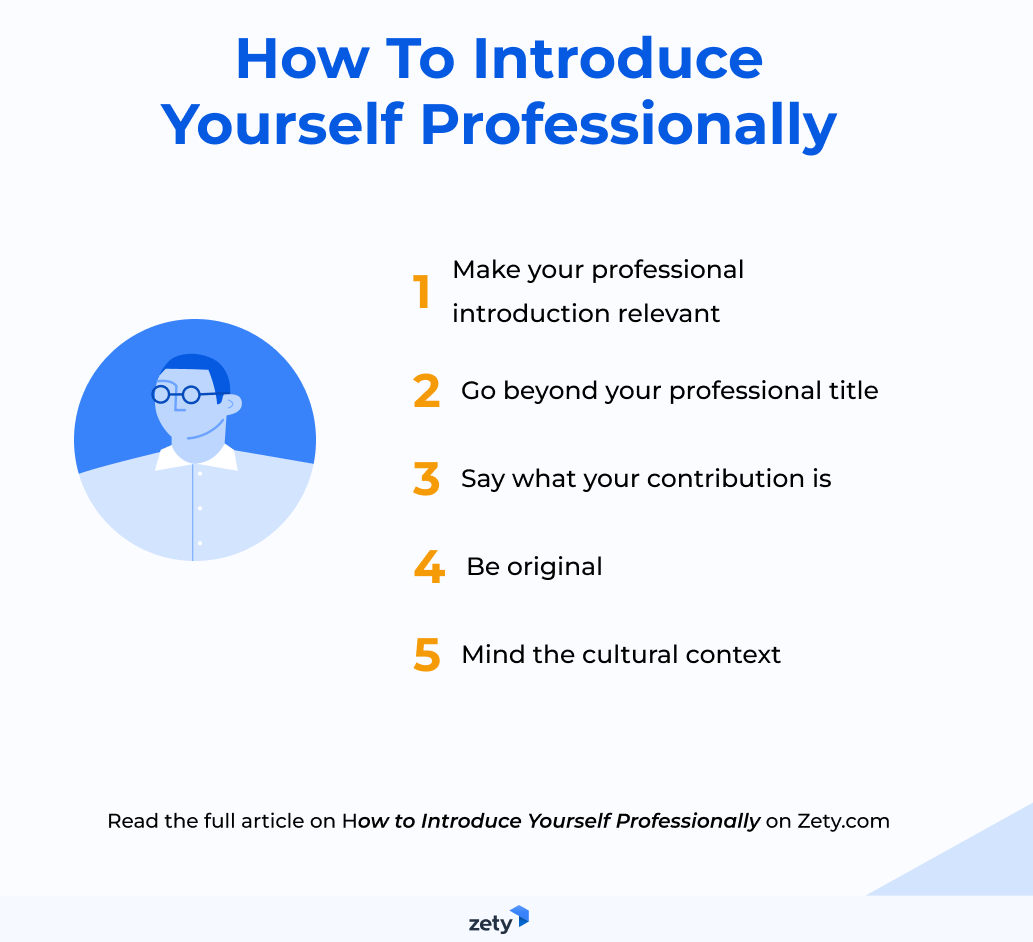
The Best Self-Introduction Method
You only get one chance to make a first impression, and it happens in just 7 seconds—that’s why your self-introduction matters. Whether in a meeting, a speech, or a written introduction, relevance is key.
So, how do you introduce yourself in a way that grabs attention? Keep it simple and structured using the Present-Past-Future framework:
- Present: Start with your name and job title. You can also mention your current project, area of expertise, or location to provide context.
- Past: Share a brief career story, highlighting relevant experience, past roles, impressive achievements, or education background. Keep it concise and focused on what’s most relevant.
- Future: Wrap up with a forward-looking statement. In a meeting, connect your introduction to the discussion. In a job interview, express how you aim to contribute to the company.
Using this structure ensures your self-introduction is clear, engaging, and memorable—helping you make the right impression from the start.
Let's see some examples:
How to Introduce Yourself Professionally—Example
Hello. I'm Samantha Reed, a Senior Financial Analyst at Global Investments. I'm currently leading a project to optimize our investment strategies using advanced data analytics.
Previously, I worked at BlueRock Financial, where I managed portfolios worth over $50 million and earned recognition for my accuracy in financial forecasting. I hold a Master’s degree in Finance from the University of Chicago.
I'm eager to leverage my expertise to help Global Investments achieve its financial goals and explore new growth opportunities.
How to Introduce Yourself in a Meeting—Example
Good morning. I'm Alex Johnson, Bright Media's new Marketing Director. I'm currently revamping our social media strategy to increase brand engagement.
I previously led a marketing team at Starline Communications, where we increased our digital presence by 40% through targeted campaigns. I also have an MBA from NYU.
In this meeting, I hope to collaborate on innovative ideas to enhance our marketing efforts and drive the success of our upcoming campaign.
How to Introduce Yourself Professionally at a Networking Event—Example
Hi, I'm Emma Brooks, a Product Manager at TechWave Solutions. Currently, I'm overseeing the development of our new AI-driven software.
Before joining TechWave, I worked at Innovatech, where I successfully launched several high-profile tech products. I graduated from MIT with a degree in Computer Engineering.
I'm here to connect with fellow professionals and explore potential collaborations that can push the boundaries of technology.
Make an even better impression and learn How to Write a Thank You Email After an Interview
Making a resume with our builder is incredibly simple. Follow our step-by-step guide, use ready-made content tailored to your job and have a resume ready in minutes.
When you’re done, Zety’s resume builder will score your resume and our ATS resume checker will tell you exactly how to make it better.
The Best Self-Introduction Tips
Keep these things in mind to introduce yourself professionally no matter the situation you find yourself in:
- Be mindful of the social context—it’s the single most important thing: make your self-introduction relevant.
- Keep your introduction concise and relevant to the context—a children’s party, focus on your role as a parent and make that the central part of your introduction. While your professional achievements may be impressive, they’re not always necessary to mention in every setting—tailor your introduction to fit the occasion.
- Acknowledge the presence of others—the best self-introduction focuses on what you have in common with the others. You’ll see how much easier it will be for everyone to establish rapport.
- Listen and be present—listening to others is a great interpersonal skill. It’s not exactly part of introducing yourself, but the next step after all introductions are made is striking up a conversation. Great conversations can only happen when people listen to each other and are present in the moment.
Read more: Best Interview Tips for 2025
What NOT to Do When Introducing Yourself Professionally
A professional introduction is your chance to make a strong first impression, but many people unknowingly sabotage themselves by making simple yet critical mistakes. There are some common pitfalls to ensure your introduction is clear, engaging, and effective.
Avoid these mistakes when introducing yourself professionally:
- Don't be too vague or generic. If your introduction lacks specificity, it won’t leave a lasting impression. Saying something broad like “I work in marketing” doesn’t tell your audience what you actually do or how you add value. Instead of relying on generic labels, focus on what sets you apart in your field. A lack of detail can make you seem unprepared or uninteresting, causing your listener to lose interest quickly.
- Don't overload your interlocutor with too much information. A professional introduction should be concise. If you try to squeeze in your entire career history, every personal project you’ve worked on, and all your professional accomplishments, you risk overwhelming your audience. People don’t need to know everything right away—only what’s most relevant to the current situation. Keep it focused and digestible to ensure your key points stand out.
- Don't memorize what you're going to say. Unless you want to sound overly scripted or robotic, avoid learning an introduction word-for-word. Sure, preparation is key, but a rigid, mechanical delivery can feel impersonal and unengaging. Instead, aim for a natural and adaptable introduction that allows for slight variations based on the context and audience. Authenticity helps build connections more effectively than a perfectly memorized speech.
- Don't be too casual or informal. While a relaxed tone can help establish rapport, being too casual can make you seem unprofessional. Introducing yourself with slang, jokes, or unrelated personal details can undermine your credibility. The way you present yourself should align with the setting—what’s appropriate at a networking event may not be suitable for a business meeting. Always gauge the level of professionalism required and adjust accordingly.
- Don't ignore your audience’s interests. An effective introduction isn’t just about you—it’s also about what’s relevant to your audience. If your introduction doesn’t provide context for how your role or expertise aligns with their interests, it may feel disconnected or self-centered. Subtly tie your introduction to the purpose of the conversation, the meeting, or the event. Making your introduction audience-focused creates stronger engagement.
- Don't lack confidence or energy. The words you choose matter, but how you say them is just as important. A weak handshake, poor eye contact, a hesitant voice, or excessive filler words (like “um” and “uh”) can make you appear uncertain or unprepared. Confidence—without arrogance—helps establish credibility. Deliver your introduction with clear articulation, good posture, and a steady tone to leave a strong impression.
Learn what questions should you ask. Read our guide: If you’re unsure what format to choose, read on: Best Questions to Ask an Interviewer in for 2025
Plus, a great cover letter that matches your resume will give you an advantage over other candidates. You can write it in our cover letter builder here. Here's what it may look like:
See more cover letter templates and start writing.
Key Takeaway
If you want to introduce yourself professionally:
- Remember to be mindful of the social context—make sure your introduction fits the situation. Be aware of why you're introducing yourself in the first place and what you want others to learn about you.
- Resonate with the audience—you’re introducing yourself to other human beings, so act like a human yourself. Smile and make eye contact. Focus on what’s relevant, don’t say too much, and avoid verbosity. Be brief and to the point.
- Last but not least—prepare. Especially if your self-introduction is part of a larger presentation to a live audience. And don’t aim for perfection. Just see to it that you've got everything right. Right is enough.
About Zety’s Editorial Process
This article has been reviewed by our editorial team to make sure it follows Zety's editorial guidelines. We’re committed to sharing our expertise and giving you trustworthy career advice tailored to your needs. High-quality content is what brings over 40 million readers to our site every year. But we don't stop there. Our team conducts original research to understand the job market better, and we pride ourselves on being quoted by top universities and prime media outlets from around the world.
Sources
- Gil Greengross, "Want to Increase Trust in Others? Just Smile"
- Kristi DePaul, "How to Get Your Resume Noticed (And Out of the Trash Bin)"
Frequently Asked Questions about Introducing Yourself
How to introduce yourself professionally?
Here are a few rules for making a good self-introduction in a business setting:
- Start with a greeting and say your name.
- State your job title and specify what’s your area of expertise.
- Say a few words about your relevant work experience and professional achievements.
- Mention your professional goals.
- Ask the other person a question to make a connection.
If you’re struggling to get the right balance between the contents and the length of your self introduction, try writing an elevator pitch.
How to introduce yourself to a new team at work?
Here are some tips to help you introduce yourself to a new team:
- Prepare a short introduction beforehand so you’re ready right away.
- Adjust your tone to the company culture—notice if it’s formal or laid back.
- Use the onboarding process to meet new colleagues and ask them questions.
- Go for lunch or coffee with your team to get to know them in a more relaxed setting.
- Send an introduction email with a short professional summary.
- Ask HR for other means of introduction, so you can connect with people from other teams.
- Use positive language to make a good impression.
- Steer away from sharing information that could be inappropriate for a work setting.
